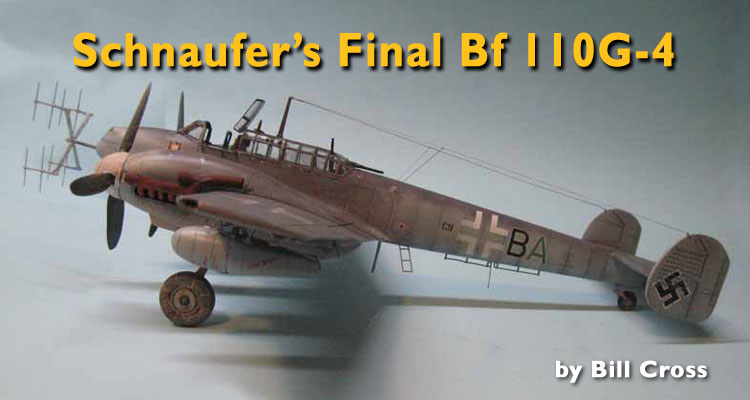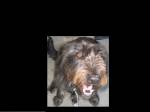1⁄32Schnaufer’s Final Bf 110 G-4
17
Comments
Many are surprised to find out that Germany’s leading defensive ace in WW II flew a Bf 110 nightfighter. Wolfgang Schnaufer in fact had 121 confirmed kills, and flew several versions of the Bf 110F and G. Ironically, he didn’t score a single victory in this, his last airframe, a G-4. I have long been fascinated with the Bf 110 in general because I like to see success snatched from the wreck of failure: The Bf 110 fits that description very well. It started out as a fighter plane intended to escort the Luftwaffe’s new fleet of medium bombers. Designed in the mid-1930s by the legendary Willy Messerschmitt at the directive of the Reichsluftfahrtministerium (RLM), the plane was built principally because Göring believed twin-engine fighters were the future of air combat. The campaigns over Poland and France seemed to prove him right when opposition was mostly the antiquated and poorly-used Polish and French air forces, and Germany’s bombers were raining terror down on mostly undefended cities.
The increase in range provided by a second engine, however, was more than cancelled out by the limitations of the added weight. The piston-driven power-plants then available to German aircraft designers simply couldn’t compete against the nimble, maneuverable single-engine fighters like the Spitfire with its fabulous Merlin engine. The small control surfaces, too (especially the tail), made the plane labor in the air, and the RAF badly humbled the 110 during the Battle of Britain. Shortly thereafter, it was diverted to other assignments, first in ground-attack roles as part of Zerstörer (“destroyer”) squadrons. Its lack of mobility and slow speed made it vulnerable as a fighter bomber. It wasn’t until the RAF’s Bomber Command began attacking Germany’s cities that the 110 found its real niche as a night fighter in the D-F and especially the G variants.
The Bf 110G’s slowness and lack of maneuverability in daylight were no problem after dark against the lumbering, unescorted British bomber formations (the 110 did not play a significant role against the US daylight bombing campaign). Its large airframe easily handled the heavy, bulky radar arrays and electronics equipment needed to hunt prey in the dark, and the requisite 3-man crews (pilot, radar operator, rear gunner) surpassed night versions of single-engine aircraft. A better power plant, larger props and bigger rear stabilizers improved the performance to the point that the G was the most-produced version.
Surprisingly, there hasn’t been a G in 1/32nd scale since Revell of Germany’s Bf 110G-4 kits from at least 25 years ago. After picking up two on eBay for reasonable prices (around $25 each), I decided to take a run at bringing one of them into the current era of modeling. With all the attention surrounding the terrific Dragon Bf 110s in 1/32nd scale, it might seem quixotic trying to fix the Revell of Germany version. After all, DML has released the C & D variants, and a D/E nightfighter is now coming onto the market. Can a G really be far behind? The Revell kit has none of the detailing we’ve come to expect from big planes today, plus some things we’d rather not have: raised panel lines, thick molding, flash, horrible seam lines, knock-out holes, “suggested” detailing in some areas and totally wrong details in others. But with Dragon only up to the E variant, and 1/48th simply too small for my aging eyes, I decided to accept the challenge.
To try and fix as many of the problems as possible, I purchased the following upgrades and did some scratchbuilding as well:
Even worse were the Peddinghaus decals: while nicely-done and generally in registration, they were printed on a single sheet of transfer film, which meant a lot more careful cutting when wetting than with conventional waterslide decals. Worse, though, was some of them were prone to losing details if handled too roughly, or simply disintegrating entirely. When adding small stenciling, it’s almost impossible to avoid manhandling them. But there’s simply no excuse for the national insignia disintegrating, which is what happened to at least half of them. I was able to repair the damage or replace them from the spares box, and I even ended up liking the “used” look it gave the aircraft.
The painting was fairly straightforward, since Schnaufer opted for a simple camo scheme of RLM 75 and 76 over a blue underbelly. He also believed a gloss finish would improve speed, so the entire thing has a coat of acrylic clear gloss. The usual MIG weathering powders handled the dust, rust and soot.
The final results were less than I’d hoped for, but much more than the original kit could attain on its own. It was an expensive ride: I ended up spending as much on the upgrades as the Dragon kit costs OOB! Will I complete the second kit? Right now, I eagerly await Dragon’s F variant and hope that a G-4 with multiple options is in the offing. If I can get my original enthusiasm back, perhaps I’ll complete the job on the other RoG kit?
The increase in range provided by a second engine, however, was more than cancelled out by the limitations of the added weight. The piston-driven power-plants then available to German aircraft designers simply couldn’t compete against the nimble, maneuverable single-engine fighters like the Spitfire with its fabulous Merlin engine. The small control surfaces, too (especially the tail), made the plane labor in the air, and the RAF badly humbled the 110 during the Battle of Britain. Shortly thereafter, it was diverted to other assignments, first in ground-attack roles as part of Zerstörer (“destroyer”) squadrons. Its lack of mobility and slow speed made it vulnerable as a fighter bomber. It wasn’t until the RAF’s Bomber Command began attacking Germany’s cities that the 110 found its real niche as a night fighter in the D-F and especially the G variants.
The Bf 110G’s slowness and lack of maneuverability in daylight were no problem after dark against the lumbering, unescorted British bomber formations (the 110 did not play a significant role against the US daylight bombing campaign). Its large airframe easily handled the heavy, bulky radar arrays and electronics equipment needed to hunt prey in the dark, and the requisite 3-man crews (pilot, radar operator, rear gunner) surpassed night versions of single-engine aircraft. A better power plant, larger props and bigger rear stabilizers improved the performance to the point that the G was the most-produced version.
Surprisingly, there hasn’t been a G in 1/32nd scale since Revell of Germany’s Bf 110G-4 kits from at least 25 years ago. After picking up two on eBay for reasonable prices (around $25 each), I decided to take a run at bringing one of them into the current era of modeling. With all the attention surrounding the terrific Dragon Bf 110s in 1/32nd scale, it might seem quixotic trying to fix the Revell of Germany version. After all, DML has released the C & D variants, and a D/E nightfighter is now coming onto the market. Can a G really be far behind? The Revell kit has none of the detailing we’ve come to expect from big planes today, plus some things we’d rather not have: raised panel lines, thick molding, flash, horrible seam lines, knock-out holes, “suggested” detailing in some areas and totally wrong details in others. But with Dragon only up to the E variant, and 1/48th simply too small for my aging eyes, I decided to accept the challenge.
To try and fix as many of the problems as possible, I purchased the following upgrades and did some scratchbuilding as well:
- 1. Eduard interior PE set (so-so and wrong on the interior detailing, but helpful in some things)
- 2. Eduard exterior PE set with scratch-built additions to the FoF radio beacon (a good value)
- 3. Peddinghaus decals (particular to the last Schnaufer plane)
- 4. Wing tanks scratch-built with vacu-form halves generously provided by John Galbraith at “Large Scale Planes” Forum, insulated wire for fuel lines and PE thumb screws on filler caps
- 5. Jerry Rutman resin spinners, props, tail stabilizers, wheel wells, tires & struts plus FuG218 radar interior avionics
- 6. Scratch-built “Schräge Musik” 2cm cannon upwards-firing array
- 7. Schatton Modellbau FuG 218 radar array (superb)
- 8. Internal wiring scratch-built
- 9. Scratch-built roll bar for pilot’s seat
- 10. Scratch-built brass grab handles in cockpit
- 11. Scratch-built brass pitot tube & external navigational arrays
- 12. Scratch-built 2cm nose cannon in cockpit flooring
- 13. Panel lines & control surface edges re-scribed
- 14. Scratch-built rear horizontal stabilizer guides (brass wire)
- 15. Scratch-built brake lines from spare Friulmodel track wire
Even worse were the Peddinghaus decals: while nicely-done and generally in registration, they were printed on a single sheet of transfer film, which meant a lot more careful cutting when wetting than with conventional waterslide decals. Worse, though, was some of them were prone to losing details if handled too roughly, or simply disintegrating entirely. When adding small stenciling, it’s almost impossible to avoid manhandling them. But there’s simply no excuse for the national insignia disintegrating, which is what happened to at least half of them. I was able to repair the damage or replace them from the spares box, and I even ended up liking the “used” look it gave the aircraft.
The painting was fairly straightforward, since Schnaufer opted for a simple camo scheme of RLM 75 and 76 over a blue underbelly. He also believed a gloss finish would improve speed, so the entire thing has a coat of acrylic clear gloss. The usual MIG weathering powders handled the dust, rust and soot.
The final results were less than I’d hoped for, but much more than the original kit could attain on its own. It was an expensive ride: I ended up spending as much on the upgrades as the Dragon kit costs OOB! Will I complete the second kit? Right now, I eagerly await Dragon’s F variant and hope that a G-4 with multiple options is in the offing. If I can get my original enthusiasm back, perhaps I’ll complete the job on the other RoG kit?
Comments
Thanks Bill.
Im going to be stubborn and scratch build them. I'm practicing this on a few kits before I return to the '110.
Worst case is she turns into a crash victim
AUG 10, 2010 - 08:26 AM
Hi Bill,
congratulations on your build ..and on actually finishing one of these!.
cheers
AUG 11, 2010 - 11:54 PM
Thanks, Neil. Anyone want to buy the other Rutman upgrade kit, LOL???
AUG 12, 2010 - 04:41 AM
dont tempt me.....
Im reaaaaaly trying to stay true to my goal of not going AM for the big stuff...
AUG 12, 2010 - 01:39 PM
Way to go Bill!!! I did one of these and spent 5 hours on the greenhouse and about 8 on the paint. Kept looking at the 3+ pages of corrections and finally said "It's a HOBBY, not a career!"
You da Man and a half, bro'!
Rick
PS- Just ordered the Special Hobby A6M5 Claude from sprue Brothers. This wil go into a dog flight display with a Chinese marked Trumpeter P-40B ......
-R
AUG 12, 2010 - 03:55 PM
Shawn, I appreciate what you say, and there are many kits, even older ones, that can be built OOB. But this one is too #$%#ed-up to live. The props & spinners are waaay undersized, the tail stabilizers are too small, the wheel wells are wrong, the avionic are just missing. And the "greenhouse" makes it difficult to avoid getting those right.
Thanks, Rick, you're too kind. I've just put the Rutman upgrade up F/S on the BST forum. I realized I've already put the avionics and scratch-built seats in, so I'm selling the plane for $10 more. Will also trade it and the Eduard exterior PE set for the new Pacific Coast Models Hurricane!
AUG 13, 2010 - 04:34 AM
Bill, for your 'G' I completely agree.
Im building the equally as f%^$ed up C4/B model, which has parts for a C7, markings for a non C4/B and markings for a C4/B.
AUG 13, 2010 - 06:40 AM
Bill,
if it isn't already sold I'm definitely interested in your Rutman set (if you accept Paypal and can post to the UK..)
cheers
AUG 26, 2010 - 12:42 AM
Not sold, and I can do both. Part of the upgrade (the avionics and other interior stuff) is in-place in the partially-built kit. I can either ship you the plane as is, or remove the upgrade stuff and ship it off that way. PM me with your preferences, email address, etc. and I'll compute the shipping to the UK.
AUG 26, 2010 - 05:20 AM
I have decided to sell the entire partially-built Revell of Germany kit (1/32nd scale), the Eduard exterior PE upgrade, the Rutman resin upgrade, and the scratch-built items already in-place (the canopies have grab handles and are masked for painting). The total retail would be over $100, but I'm happy for $70 plus shipping.
SEP 08, 2010 - 06:02 AM
Copyright ©2021 by Bill Cross. Images also by copyright holder unless otherwise noted. The views and opinions expressed herein are solely the views and opinions of the authors and/or contributors to this Web site and do not necessarily represent the views and/or opinions of AeroScale, KitMaker Network, or Silver Star Enterrpises. Images also by copyright holder unless otherwise noted. Opinions expressed are those of the author(s) and not necessarily those of AeroScale. All rights reserved. Originally published on: 2010-08-07 00:00:00. Unique Reads: 22110









































